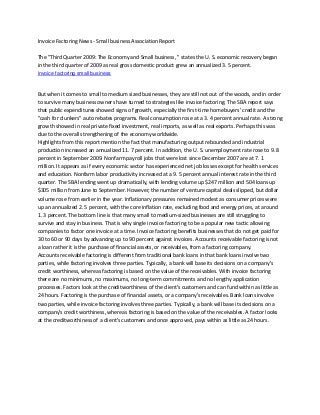
Invoice factoring small business 21
- 1. Invoice Factoring News - Small business Association Report The "Third Quarter 2009: The Economy and Small business, " states the U. S. economic recovery began in the third quarter of 2009 as real gross domestic product grew an annualized 3. 5 percent. invoice factoring small business But when it comes to small to medium sized businesses, they are still not out of the woods, and in order to survive many business owners have turned to strategies like invoice factoring. The SBA report says that public expenditures showed signs of growth, especially the first-time homebuyers' credit and the "cash for clunkers" auto rebates programs. Real consumption rose at a 3. 4 percent annual rate. A strong growth showed in real private fixed investment, real imports, as well as real exports. Perhaps this was due to the overall strengthening of the economy worldwide. Highlights from this report mention the fact that manufacturing output rebounded and industrial production increased an annualized 11. 7 percent. In addition, the U. S. unemployment rate rose to 9. 8 percent in September 2009. Nonfarm payroll jobs that were lost since December 2007 are at 7. 1 million. It appears as if every economic sector has experienced net job losses except for health services and education. Nonfarm labor productivity increased at a 9. 5 percent annual interest rate in the third quarter. The SBA lending went up dramatically, with lending volume up $247 million and 504 loans up $305 million from June to September. However, the number of venture capital deals slipped, but dollar volume rose from earlier in the year. Inflationary pressures remained modest as consumer prices were up an annualized 2. 5 percent, with the core inflation rate, excluding food and energy prices, at around 1. 3 percent. The bottom line is that many small to medium-sized businesses are still struggling to survive and stay in business. That is why single invoice factoring to be a popular new tactic allowing companies to factor one invoice at a time. Invoice factoring benefits businesses that do not get paid for 30 to 60 or 90 days by advancing up to 90 percent against invoices. Accounts receivable factoring is not a loan rather it is the purchase of financial assets, or receivables, from a factoring company. Accounts receivable factoring is different from traditional bank loans in that bank loans involve two parties, while factoring involves three parties. Typically, a bank will base its decisions on a company's credit worthiness, whereas factoring is based on the value of the receivables. With invoice factoring there are no minimums, no maximums, no long-term commitments and no lengthy application processes. Factors look at the creditworthiness of the client's customers and can fund within as little as 24 hours. Factoring is the purchase of financial assets, or a company's receivables. Bank loans involve two parties, while invoice factoring involves three parties. Typically, a bank will base its decisions on a company's credit worthiness, whereas factoring is based on the value of the receivables. A factor looks at the creditworthiness of a client's customers and once approved, pays within as little as 24 hours.